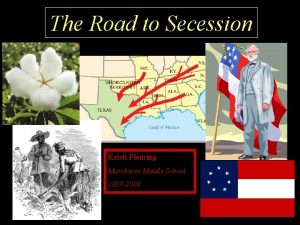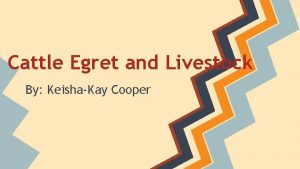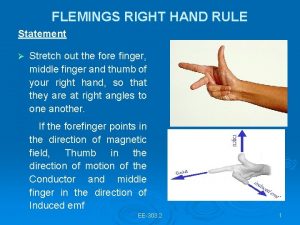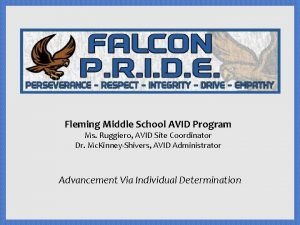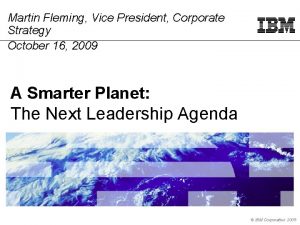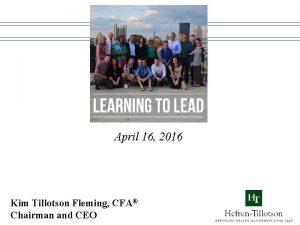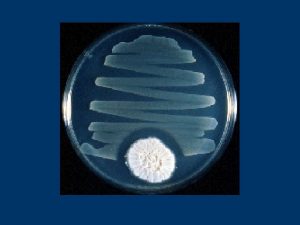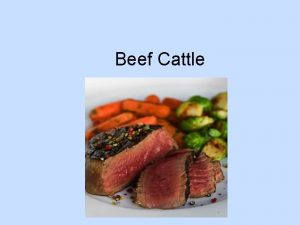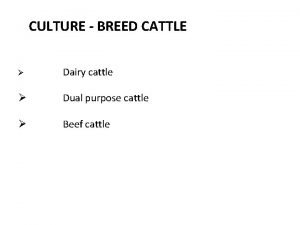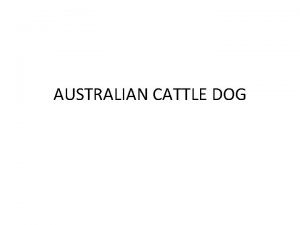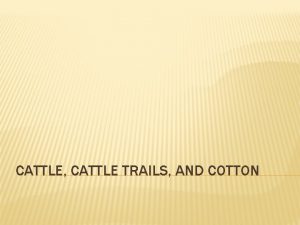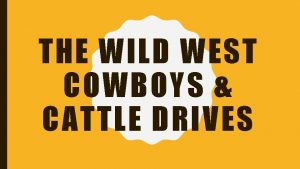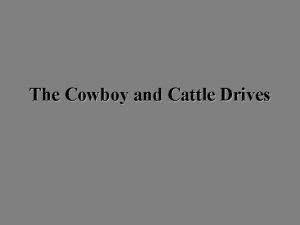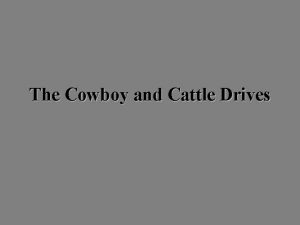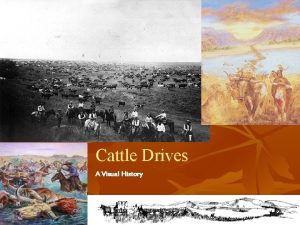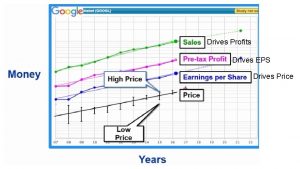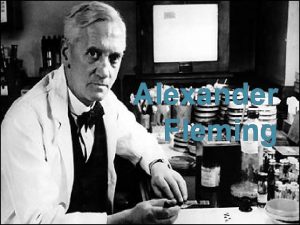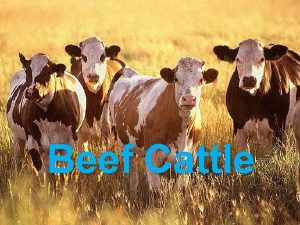Kristi Fleming Cattle Drives A Visual History TX



















- Slides: 19

Kristi Fleming Cattle Drives A Visual History TX History Murchison Middle Spring 2007

Beginnings of the Cattle Industry of the 19 th Century Began with the Spanish in the 1500 s… The Spanish explorers brought the first cattle to Texas in the 1500 s. Some of the cattle escaped and roamed throughout parts of Texas. The Spanish missions of the 1600 s and 1700 s later started raising cattle. South Texas Cattle “Diamond” Cattle herds, because they were neglected during the Civil War and wire fences had not yet been invented, roamed wild on the South Texas Plains during the 1860 s and 1870 s. Many of these cattle were rounded up and driven to cattle markets and railroads further north. The area in which much of these cattle roamed before they were rounded up is sometimes referred to as the cattle “Diamond” of Texas. South Texas Cattle “Diamond” A native vaquero, or cowboy, tends cattle on the mission ranch. Although most were unbranded and roamed freely, cattle were the lifeblood of the mission, providing meat and hides for the mission residents as well as important commodities for revenue. With up to 40, 000 head of cattle at one point, Mission Espiritu Santo was the first large cattle operation in Texas.

What Type of Cattle Were Driven? Which of these cattle do you think would do best on the 900 mile trip from Texas to the railheads in Kansas? Why? Today’s longhorn Original longhorn The original Texas longhorn was typically skinner and leaner than your typical beef cattle today. Why? Because in the 1880 s, we needed cattle that could survive the long walk to the railheads. Today, we have the technology to transport them to the slaughterhouse. Think about the difference between a weightlifter’s body and a marathon runner’s body. If you were a Tonkawa, which one would you rather eat? Longhorns were a mix of Spanish stock and English cattle. Even though immune to diseases, they carried some cattle diseases to other ranchers outside Texas. The most devastating disease was known as “Texas fever”. Cattle Tick

Why Did Ranchers Start “Driving” Cattle? It’s all about the money… Even the Natives knew that the most important thing to most whites was money. (Remember the chief who compared the Native’s buffalo to the White’s money? ) The Cattle Business in Texas became profitable after the Civil War for three main reasons… Trail Driving was The High Price of Cattle and The Expansion of the Economical: the High Demand for BEEF Railroads: in the Northern and Eastern Railroads in the 1860 s and 1870 s Only 12 cowhands were expanded westward allowing ranchers needed per 2000 head of U. S. : The price of cattle in the Southwest was about $4 a head… the same steer went for $30 to $40 a head “up east”. the opportunity to get their cattle to cattle at a cost of only these markets “up east”. They would $1 a head. drive cattle to railroad towns and put them on the train to the Chicago and St. Louis stockyards.

Ranchers You Should Know Jesse Chisholm n n 1865 – created the FIRST cattle trail called the Chisholm Trail (trail to Kansas) Indian interpreter who spoke 14 different languages Established the first cattle trail from the Rio Grande to railheads in Kansas Related to Sam Houston-how? Charles Goodnight n n n n 1865 – created the Goodnight-Loving Trail (Trail to NM, CO and WY) 1876 - JA Ranch One of the greatest of the cattlemen He and his partner Oliver Loving blazed a trail from Fort Concho in TX to railheads in Colorado and Wyoming Loving was killed by the Comanche, but Goodnight continued Established a ranch in the Panhandle at Palo Duro Canyon called the JA Ranch with partner John Adair Kept a herd of about 250 buffalo occasionally donating one to Comanche and Kiowa who rode to his ranch from their reservations with a request to kill one “for old times sake”

Major Cattle Ranches South TX Ranches n KING RANCH Richard King, Henrietta King, Robert Kleberg XIT Ranch Panhandle Ranches n JA RANCH John Adair, Charles Goodnight n XIT RANCH JA Ranch Shoe Bar Ranch Matador Ranch After the capitol building in Austin burned down in 1881 the Farwell brothers of Chicago agreed to build a $3 million capitol in exchange for 3 million acres of land in the Panhandle… they started the XIT with the land n SHOE BAR RANCH Thomas Bugbee n MATADOR RANCH H. H. Campbell and others CAMP RANCH Wilson County King Ranch

Major Cattle Trails Cheyenne Ogallala Denver Ellsworth Pueblo Dodge City Abilene Baxter Springs KEY Goodnight-Loving Trail Great Western Trail Chisholm Trail Fort Concho Sedalia (Shawnee) Trail Towns Forts Railroads Rivers Austin Kerrville Sedalia

Wrangler Remuda Swing Point Flank Chuck wagon Trail Boss Drag Flank Swing Point TYPICAL CATTLE DRIVE FORMATION This diagram shows a typical cattle drive formation. The Pointers guided the cattle in the desired direction; the Swing Riders, behind the Pointers, assisted in guiding the cattle, and in keeping the herd in formation. The Flank Riders worked at keeping the formation intact. The Drag Riders, the most undesirable position because of the dust , depending upon the wind, kept the weaker, lagging cattle from slowing the formation down. GREAT little History Channel video on cattle drives

Jobs Along the Trail Boss n Qualifications Leadership, Competence, Cooperative, Cool-headed, Resolute, Quick thinker, Previous experience with cattle drives n Duties n n n n Responsible for entire operation (money, cowboys, cattle) while on trail Involved in finding water, grass, and good trail for cattle Can track different animals across the range; knows the range well Keeps peace between cowboys Keeps horses and cowboys fed Handles money involved with placing orders for supplies and paying appropriate tolls Pay (1890 s) - $90/month Pay (2010) - $2156/month Zack T. Burkett, LS Foreman, Overlooking the Canadian River, 1907

Chuck Wagon Cook A JA Cook Inspecting His Stew, JA Ranch, Texas, 1908 Legendary ranchman and trail driver Charles Goodnight invented the chuck wagon in 1866 for use by his crews. The chuck wagon, sometimes drawn by oxen, but usually by mules, carried not only food, utensils and a water barrel, but also tools and the crew's bed rolls. A fold-out counter, supported by one or two hinged legs, was used for food preparation. The wagon contained several drawers and shelves, with a "boot" or storage compartment underneath, all covered by a canvas top. The cook served beef and bison steaks, SOB stew (made from calf parts), "chuck wagon chicken" (bacon), "Pecos strawberries" (beans), "sourdough bullets" (biscuits) and cowboy coffee. The Matador wagon cook [Harry Stewart] making a cobbler. Matador Ranch, Texas, 1908 Qualifications Must know how to drive a wagon, be able to prepare meals with limited resources and serve them on time, some experience and knowledge of medical techniques also necessary Level of Experience n HIGH; former cowboy who is either too old for the more difficult work or has been hurt Duties n Prepares 3 meals a day out of the back of a wagon n Not expected to assist with any cattle or other trail jobs n Cooks for the men on the trail n Moves wagon about two times a day, 10 -15 miles each time n Awakens at 3 am and has breakfast ready when the others are awakened n Pay (1890 s) - $60/month n Pay (2010) - $1437/month The Matador outfit having dinner at the chuck wagon. The noon meal is known as "dinner" in the ranch country. Matador Ranch, Texas. , 19081909

Point n n n Qualifications Reliable, ability to work in a group with others toward a common goal Level of Experience n High; most honored post on the drive. These cowboys would determine the direction of the drive. Duties n Works in groups of two and points the lead steers in the right direction n Sets the pace for the drive n Pay (1890 s) - $30 -40/month n Pay (2010) - $719 -958/month Swing n n n Qualifications Must know how to ride a horse, previous experience with trail drives Level of Experience n Some experience required Duties n Rides a third of the way back from the front of the herd as it is moving down the trail n Pay (1890 s) - $30 -40/month n Pay (2010) - $719 -958/month

Flank n n n Qualifications Must know how to ride a horse, previous experience with trail drives Level of Experience n Some experience required Duties Jack Woffard of the Shoe Bar outfit flanking the n “Cuts in” cattle that have gotten out of trail herd. Shoe Bar Ranch, Texas, 1912 the herd n Rides about 2/3 of the way back from the front of the trail n Makes sure that cattle do not wander too far away from the main herd n Qualifications Pay (1890 s) - $30 -40/month Willing to work hard and endure dust and dirt Pay (2010) - $719 -958/month kicked up by the herd and riders ahead of them n Level of Experience n Usually an entry-level position n Duties n Rides at the back of the herd on the trail to make sure that beeves, cows, etc. stay with the herd n Must be able to “push” these slower cattle forward Drag n n Two OR cowboys roping an outlaw steer, 1909 n Pay (1890 s) - $30 -40/month n Pay (2010) - $719 -958/month

Wrangler Qualifications Willing to learn and work hard Level of Experience n ENTRY-LEVEL POSITION, generally a young boy who wants to be a cowboy Duties n n Erwin E. Smith (1886– 1947) Smearing His Loop on a Wild One [A JA Cowpuncher Making a Houlihan Catch in the Remuda as the Horses Attempt to Dodge His Lariat], JA Ranch, Texas, 1908 n n n The boy wrangler for the Shoe Bar brings in a load of wood, the cowboy's favorite method of "totin' things", 1912 The wrangler was usually a young boy who worked as an apprentice to learn the ways of a cowhand. His primary responsibility was to care for the remuda (herd of horses). In the morning he rose before the men to round up all the horses that might have wandered away in the night. He had to keep them together until they could be roped for the men to ride. One of the most popular cowboy songs of all time, “Little Joe, the Wrangler, ” written by Jack Thorp in 1898, told the story of a youngster who worked hard at a “man’s job” and died tragically when the herd stampeded during a storm. Drives the remuda before the wagon and ahead of the cattle Rounds the extra horses up and gets them into a rope corral several times during the day Keeps the horses together and eating grass until it is time for cowboys to change mounts Makes sure that those ridden hard are given proper food (corn and grass) Helps cook gahter wood and harness the teams of horses n Pay (1890 s) - $25/month n Pay (2008) - $600/month Often horses in the remuda would dodge cowhands’ attempts to rope them, making rope-handling skills all the more important. In this image, the cowhand is roping his mount for the day, using a smear or houlihan catch. A roper had different throws for different purposes; the smear or houlihan catch is a fast overhand throw with an open loop, rather than a side or spinning throw, which required more room to execute. The houlihan catch is performed quickly and in a tight area.

Cattle Branding Cattle brands were used to mark a rancher’s cattle. Each ranch had their own brand that they would register with the county. If someone else tried to sell the cattle, they would be arrested for stealing cattle or “cattle rustling”. Ask about the XIT cattle rustlers story… Click here for branding explanation and game http: //www. pbs. org/wnet/ranchhouse/pop_cattl edrive/stampede_flash. html Cowboys branding "mavericks" in the 1880's. This cowboy name for cattle without a brand can be traced to Texas rancher Samuel Maverick, whose habit of neglecting to brand his herd led his neighbors to call an unbranded steer "one of Maverick's. " Photograph by F. M. Steele Payback time at the ranch.

XIT Ranch After the capitol building in Austin burned down in 1881 the Farwell brothers of Chicago agreed to build a $3 million capitol in exchange for 3 million acres of land in the Panhandle… they started the XIT with the land XIT Cattle Rustlers were stealing cattle off the XIT Ranch in large numbers. In those days, cattle rustlers were usually hung. However, when these rustlers were finally caught the one of the owners of the XIT told them that he would spare their lives if they just could explain how they had been changing the brands in order to sell the cattle. The rustlers told the XIT owners how they changed the brand saved their own lives in the process.

Ms. Fleming’s Family Brands n Papa’s – Bar LC LC My Great-Grandfather (Louis Charles George) n LC’s – Diamond G G My Great-Uncle (Louis Charles George, Jr. ) n Roland’s – Rockin’ R R My Great-Uncle (Roland George) Brands were registered by county, so no two brands could be the same in any one county. These brands are registered in Wilson County about 30 miles south of San Antonio.

Resources n Erwin E. Smith (1886– 1947) Great photos! http: //www. cartermuseum. org/collections/smith/

Expansion of the Railroads, After the Civil War (1870 s)

 Kristi fleming
Kristi fleming Kristi fleming
Kristi fleming Cattle egrets and livestock
Cattle egrets and livestock Fleming crim
Fleming crim Vark inventory
Vark inventory State fleming’s left hand rule.
State fleming’s left hand rule. Fleming's right hand rule
Fleming's right hand rule Alexander fleming middle school
Alexander fleming middle school Groucho marx erin fleming
Groucho marx erin fleming Martin fleming ibm
Martin fleming ibm Kevin fleming phd
Kevin fleming phd Kermin fleming
Kermin fleming Dc motor torque calculation
Dc motor torque calculation Fleming college jobs
Fleming college jobs Kim tillotson fleming
Kim tillotson fleming Wilfried fleming
Wilfried fleming Solar time
Solar time Alexander fleming
Alexander fleming Fleming petri dish
Fleming petri dish Piers fleming
Piers fleming
